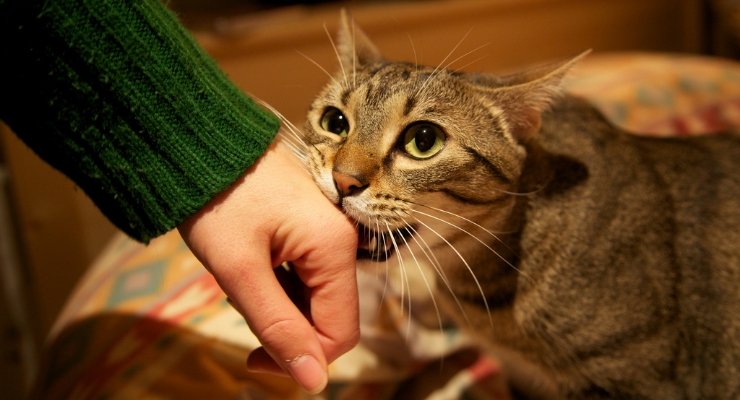What Is Redirected Aggression in Cats?
Redirected aggression in cats can result in the cat lashing out at other animals or their humans, but positive reconditioning may help. Read on for more info.

When Tim and I were first married, we occasionally took in feline lodgers for friends. They never stayed long, but our cats Cricket and Kilah were definitely not amused.
The odd part was, they never went after the guest cats. The sisters would always turn on each other, going into high gear with a “it’s your fault; no, it’s your fault” drama.
Their behavior struck us as kind of funny. We didn’t know then that it had a name — redirected aggression — and that there wasn’t anything funny about it. Our girls just happened to have a relatively mild case of it.

Don’t leave your pet’s safety to chance
Sign up for Petful recall alerts today.

Types of Cat Aggression
Actually, there are more types of feline aggression than you can aim a squirt bottle at. Speaking of which, you may want to watch that trigger finger. I’ve used squirt bottles to deal with less-than-desirable cat behavior, but there is now some controversy about how effective they really are.
These are just a few of the aggressive behaviors that the Cornell Feline Health Center lists:
- Play aggression, according to the folks at Cornell, is “usually seen in kittens that were not raised with littermates or playmates, are under-stimulated or lack appropriate play outlets.” The experts advise using noise deterrents (that is, making hissing sounds or blasting a compressed-air canister). It’s also a good idea to provide cat trees and interactive toys such as feather-tipped fishing rods.
- Fear aggression rears its ears-laid-back head at anything unfamiliar and/or unpleasant. It could be a strange person or animal; it could be a trip to the vet. Whatever it is, “do not console her. Kind words and petting communicate your approval of her inappropriate behavior.” And don’t show fear in front of her either.
- Predatory aggression is self-explanatory. If you have small “prey” animals and/or birds, don’t allow your mighty hunter near them. If the wildlife outside agitates him, then move your bird feeders and bungee-cord your trashcans.
- Pain-induced aggression is easy enough to understand. Handle your hurting cat gently — with extra-thick gardening gloves if necessary — and crack open the kitty treats. But if she’s still ornery, don’t pet or “poor kitty” her. Doing so encourages the behavior. Or so says Cornell — I’m not sure I agree.
What is Redirected Aggression in Cats?
Something has set your cat off: his next-door rival, a dog or even a bird at the feeder. Agitation sets in. Unable to deal with the cat or dog outside, he turns and lashes out — at you. Or, as animal behaviorist Jim Ha puts it, he “will exhibit an appropriate behavior at an inappropriate target.”
Sometimes it’s harder to connect the dots. Ha talks about a case involving a cat, Milo, who suddenly and inexplicably began destroying curtains.
The animal behaviorist did some detective work and “discovered that another one of the cats in the house had recently been ill, had spent a night or 2 in the veterinary hospital, and had come home a day before the first curtain ‘attack.’” Milo hated going to the vet’s office — so his housemate coming home smelling like the clinic immediately set him off.
Redirected aggression in cats is, as cat behaviorist Pam Johnson-Bennett explains, “often misdiagnosed as unprovoked aggression because it appears as if the cat is lashing out for no reason whatsoever.”
You, the (normally) beloved human and dispenser of good things, just happen to wander by, “not even looking at your cat, when suddenly you’re the target of her aggression. Redirected aggression can also be directed at other companion cats or dogs in the home.”
Basically, your outraged cat isn’t seeing you, the other cat or the dog. They are seeing the strange cat/dog/raccoon/fox — a potential rival or threat — who pushed their way into their yard, and whoever’s in the room with them has become a substitute for all that pent-up aggression.
Dr. Nicholas Dodman tells the story of 2 of his cats — mother and daughter and “the best of friends” — who suddenly found themselves “almost face-to-face” with a visiting tomcat on the other side of the screen door. Dodman reacted quickly: Just as the mother-and-daughter team were getting ready for a fight, he managed to separate them, using a chair “like a lion tamer.” He herded them into different rooms and keep them separated overnight.
In the morning, he “put his trust in what I knew, reintroducing them once they were acting calmly…. The storm was over and they never ever exhibited hostility to each other again to each other again for as long as they lived.”
Redirected Aggression in Cats Towards Humans?
Clearly, it is possible for your cat to turn on you if they are experiencing feelings of aggression towards something else that they cannot access. If you are the closest target, it’s possible your annoyed cat will redirect their feelings towards you. Thus, it is not just other cats or animals who can become the targets of redirected aggression in cats, its humans too.

How to Deal With Redirected Aggression in Cats
Ha used positive reconditioning — food — to deal with Milo’s behavior. The trick worked, and the cat’s anxiety was gone within days.
Some other things you could do include Feliway plug-in diffusers to relax your cat. Some cat caretakers have had luck with these, but I’m not one of them. Initially, our cats seemed to respond positively to them. After a few days, however, they’d begin spraying like crazy.
You can also try anti-anxiety medications, such as diazepam. These can, however, make your cat sluggish.
Not-So-Friendly Feline Fire
When it comes to redirected aggression in cats, our instinct is to rush in, grab the cat and soothe them.
Don’t. In one case that Animal Friends of Connecticut dealt with, Sabrina, a young Abyssinian mother, went ballistic when she saw a tomcat lurking around outside and lunged at the screen door. Her human’s girlfriend tried to run interference and got badly clawed and bitten. The boyfriend pitched the cat outside, saying that she was “mean.”
Sabrina was, of course, nothing of the sort. She was simply protecting her kittens from a perceived threat. By stepping in between her and the screen door, the girlfriend had unwittingly redirected the cat’s maternal fury to herself. The organization in turn stepped in and placed Sabrina in a far better home.
How to Stop Redirected Aggression in Cats
Tips for this are varied. Try to leave your cat alone until he has a chance to calm down. If another cat in the house is getting the brunt of the redirected aggression, then separate them. Switch their litter boxes back and forth during this time; give them rubdowns with towels and do the same so that their scents mingle.
And never underestimate the value of play in bringing estranged cat friends back together. Break out the old fishing toy. What works for the kitten will work for the cat.

When Redirected Aggression Takes Over Your Multi-Cat Household
According to Ingrid Johnson, redirected aggression in cats is “one of the most common forms of aggression among cats living in the same household.” She believes that it shows up most frequently “in households with 5 or fewer cats. It rarely occurs in homes that are very saturated in cats.”
Personally, I don’t think that it matters how many — or how few — cats you have. They are highly sensitive animals and react strongly to all kinds of outside stimuli. They’re contradictions in fur suits.
They’re predators, so they tend to be territorial; on the other hand, like horses, they can be easily spooked.
Cats and other animals wandering through the yard aren’t the only cause of redirected aggression, but they’re a major one.
So do what Johnson-Bennett calls “environmental modifications to reduce your cat’s chances of exposure to the triggers”:
- Cover the lower half of key windows with an opaque material or decorative window films. Kathie Cote uses the latter in her house: Her Titan gets agitated when he sees an outdoor cat and “goes from window to window with this horrible miaow.” Once he gets to the treated windows, he’s fine.
- Have a squirt gun on hand for your backyard visitors.
- Medication is always an option, but please consult your vet first.
These are only a few ways of dealing with the problem. But the point is, there are ways, and they’re worth trying.
Frequently Asked Questions (FAQ)
How Long Does Redirected Aggression Last in Cats?
How long redirected aggression in cats can last can vary from a few minutes to hours, and in some cases, possibly even days. The duration depends on the cat’s temperament, the severity of the trigger, and how the situation is managed afterward.
How to Stop Redirected Aggression in Cats?
Some possible tactics you could try that may help to stop redirected aggression in cats includes identifying the trigger and separating the cats if necessary. Providing them a quiet, safe space for the cat to calm down could help as well. If the aggression persists, consult a veterinarian or animal behaviorist for further advice.
Why Do Cats Bite You?
Cats may bite for various reasons, including playfulness or overstimulation, etc. Fear or defensive biting also happens when a cat feels threatened or stressed out, so be aware.







